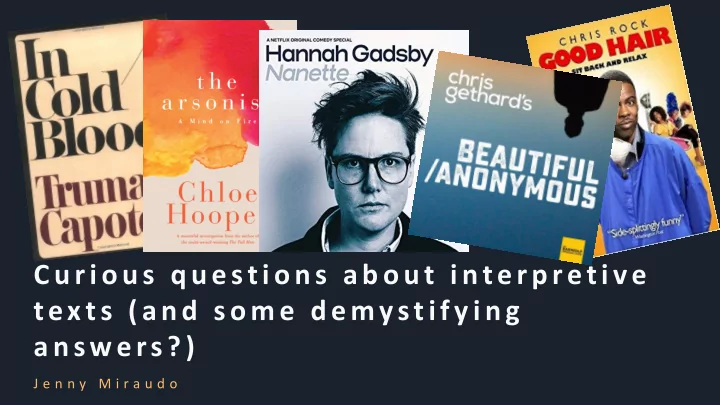

Curious que stions about inte rpretive texts (and som e de mystif ying answe rs?) J e n n y M i r a u d o
“Curiosity must accompany us on our learning journey. We need a sense of wonder to keep us pushing deeper, anticipating what might lie around the next corner – whether it is a talking toadstool or new knowledge on the next page of a book. A curious mind delights in answers it finds. It anticipates learning something new or getting to the bottom of a nagging question. A curious mind is addicted to learning.” Goodwin et al., 2018. How Curiosity, Peer Coaching, and Teaming Can Change Your School.
Session Objectives 01 02 Articulate a theoretical framework to Consider the ambiguity, depth and define the interpretive text type within nuance of the interpretive text type. the context of the WA syllabus. 03 04 Explore examples of interpretive Acknowledge the importance of teacher texts and the importance of generic curiosity in fostering student interest, distinctions. engagement and growth.
Expository A Brief History of Interpretive Texts Texts • “Meant to explain”, the adjective interpretive dates back to the 1560s, from the past participle stem of the Latin word interpretati , meaning to “explain, compound and understand.” Discursive Texts • Defined in the ATAR English syllabus as “texts whose primary purpose is to explain and interpret personalities, events, ideas, representations or concepts.” Interpretive • These classifications are intended to be general, not Texts “static or discrete.”
German Reception Aesthetics Rezeptionsästhetik
Contemporary Memoirs “The best ones are not narcissistic recounting of triviality, nor a text version of reality TV, but rather an honest unfolding of human struggles and triumphs, from which important lessons are learned and preserved, experiences are braided together in the cord of lived experience.” D, Kirby & D Kirby. 2010. Contemporary Memoir: A 21 st -Century Genre Ideal for Teens
Tools of the Novelists and Poets Contemporary Memoir Episodic structure: making use of “mini stories” Figurative language Symbolism Conventional narrative structures: Dialogue Post-modern continuity and artistic Character structures: unity Interior development gaps, omissions, monologue tenuous connection to truth
Responding and composing: four practical ideas • Triptych memoirs • Multiple scenes from one place • “Thread and cord” stories • Multiple views on a writer’s life
Participatory Journalism
Social networks Comments Individual Blog posts Participatory Journalism News articles and feature articles Opinion pieces Institutional Guest columns
Jenny Miraudo jenny.miraudo@cewa.edu.au
Recommend
More recommend